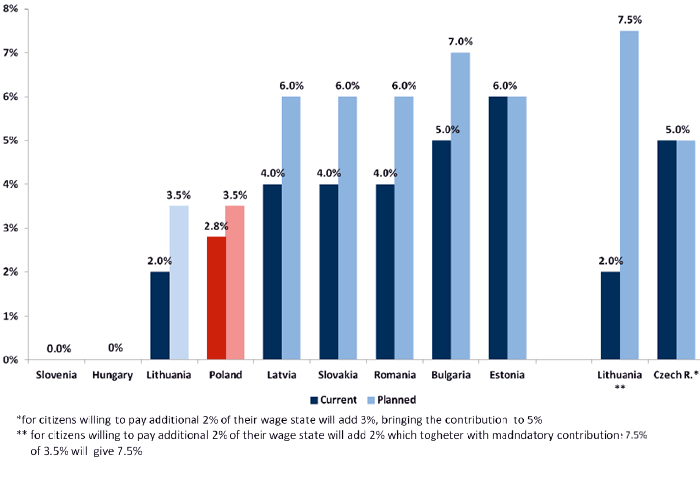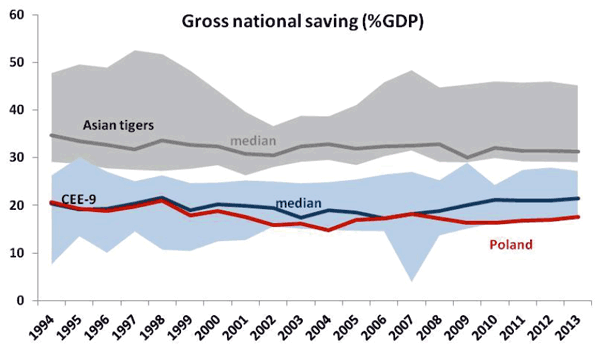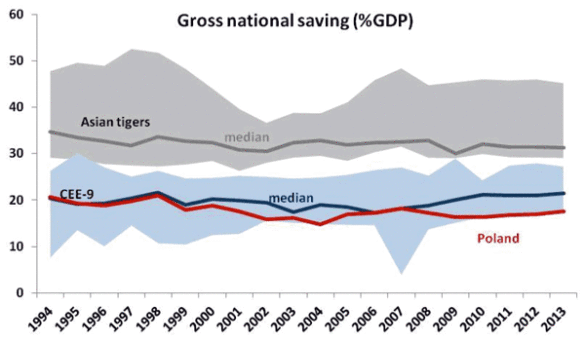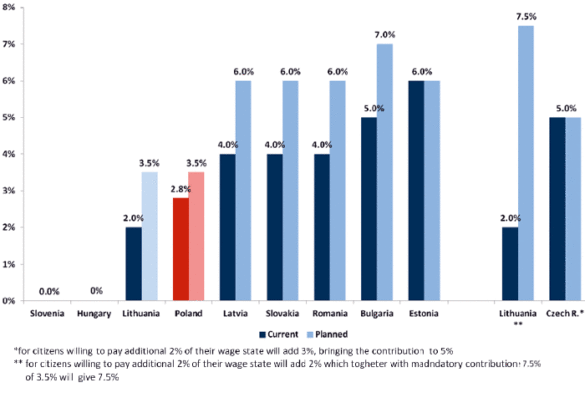In November 2011, for the ?rst time in the post-socialist era in Poland, the incumbent government was re-elected for the second turn in the of?ce. The coalition of the Civic Platform (Platforma Obywatelska) and Polish People’s Party (Polskie Stronnictwo Ludowe) maintained suf?cient electoral support and, hence, received mandate to continue with the political legacy commenced in the late 2007. This was despite the fact that in many countries the incumbents were treated as scapegoats for triggering economic crisis (Greece, Italy – Silvio Berlusconi’s government) or pursuing austerity measures (France, Italy – Mario Monti’s government). Similar political turmoil did not occur in Poland since, contrary to the other EU countries, it did not experience recession in years 2009- 2011.
1- Political economy background
It is worth noting that in 2009 Poland was the sole country in the EU to preserve positive economic growth and in years 2010-2011, along with other central-eastern EU member states, Poland was a growth leader. However, those favourable economic circumstances, which undeniably contributed to the incumbents’ re-election, turned out to be the smokescreen of the lame public ?nance stance in Poland.
Despite the effort to consolidate public ?nance, the general government de?cit amounted to 3.5% of GDP in 2012 (reduction by 4.4 percentage points between 2010 and 2012). This level of de?cit is still above the European threshold of 3% of GDP and does not permit ceasing the excessive de?cit procedure imposed on Poland by the European Commission in May 2009. Although this level of the total de?cit is not particularly excessive as compared to the EU average of 3.8% of GDP, worse picture emerges whenever one looks at the structural (cyclically- adjusted) indicators of budget balance. According to the European Economic Forecasts from 2013, Polish de?cit expressed in structural terms reached the level of 3% of GDP, i.e. 0.3 percentage points higher than the means for the EU. Consequently, the de?cit in Poland only to a minor extent can be explained by the operation of automatic stabilizers. It is rather a result of the discretional political decisions.
Strikingly, during the whole post-socialist era Poland observed only one budget surplus in 1994. As a consequence of this cascade of de?cits, substantial public indebtedness was accumulated. According to ESA-95 methodology, in 2012 the gross public debt in Poland hit 55.8% of GDP. Theoretically, it was above the precautionary threshold of 55% of GDP imposed by the Law of Public Finance of 2005. This legislation puts forth the preventing mechanisms for breaching of the constitutional ?scal rule limiting public debt in Poland to 60% of GDP. The debt threshold of 55% of GDP has crucial political implications. After exceeding this level, the government is required by law to enact the budget act without any de?cit. However, the necessity of enacting de?cit-free budget for 2013 did not materialize due to the fact that less encompassing de?nition of public debt is applied in Poland. For instance, some off-budget activities such as the debt issuance by the Road Fund are not revealed in the of?cial public debt statistics. As a result of those ?scal gimmickries, at the end of 2012 the indebtedness in Poland attained roughly 53% of GDP and avoided the legalization of the de?cit- free budget for 2013.
Regardless of the methodology at work, the public debt in Poland should be considered as high, particularly as juxtaposed with the debts of countries with similar level of socio-economic development. For instance, among former socialist economies that are currently the members of the EU, only Hungarian indebtedness is higher (78.6% of GDP) than the one observed in Poland. This permanently high debt might have severe negative economic consequences. Even without considering long-term adverse effects of excessive and chronic debt, i.e. higher taxation, in?ationary pressures, more volatile exchange rates and deeper economic inequalities, the yearly tangible cost of debt (debt servicing cost) accounts for 2.7% of GDP in 2012. This is more than the annual general government expenditure on the police service and the tertiary education jointly.
All abovementioned ?scal burdens and negative assessments of Polish tax system by the international organizations (see Doing Business ranking in the following section) pressure the government to further reform public ?nance during the second term in the of?ce. The need for reforms echoed in Prime Minister’s exposé from 2011, where particular tax reforms and amendments to the pension system were announced. Those declared changes were to a large extent the continuation of earlier reforms aimed to increase taxation, broaden tax base, decrease disability pension, modify public pension system and dismantle private one (see Yearbook on Taxation 2011, 2012).
2- Fiscal Reforms In 2012: Good, Bad and Ugly
In line with the Prime Minister’s announcements, the year 2012 brought several public ?nance reforms. Those reforms could be classi?ed as good, bad and ugly to paraphrase the title of a famous American western.
+2.1- Good (But Could Be Better)+
After abolishing earlier pensions and thus increasing effective age of retirement during the ?rst turn in of?ce (before this reform Poland had the lowest effective retirement age in the OECD, i.e. 57 years for men and 55 years for women), the government continues reducing pension privileges also after the re-election. The reform is twofold. First, it limits special privileges of uniformed services. Police of?cers, uniformed public of?cers and soldiers will work 10 years longer (increase from 15 to 25 years). In addition, they will acquire pension rights after ful?lling age requirement, i.e. minimum 55 years old. Although this change constitutes a move into the right direction, it seems that the reform could be much bolder making the uniformed service pension system even closer to the general system. For instance, in Germany policeman retire at the age of 60 the earliest. In the Netherlands, in turn, there is no special pension system for uniformed service. That means that policemen, for example, retire at the age of 65.
The second crucial reform relies on the equalisation and gradual increase of the retirement age for men and women. Targeted retirement age is 67 and is meant to be reached in 2020 for men and in 2040 for women, after increasing the retirement age by 3 months each year. Also in this case, one could cast that the age increase is too sluggish since it merely slows down the worsening of the proportion between population in the working age and retired population. While currently there are on average 3.71 persons in working age per every retired person, after the reform this ratio will drop to 3.45 and in 2021 further to 3.13. If instead the increase of retirement age had been faster at 9 months each year, this proportion could be kept stable around 3.8-3.9. While the current reform is supposed to generate public saving of PLN 25.8 bln, the alternative scenario could result in PLN 40.4 bln savings in 2022 (Bukowski and Lewandowski 2011).
The amendment of the personal income tax regulation was the third ?agship reform in taxation. The reform abolished the tax relief for Internet and limited the tax bene?t for copyright contracts. The 50 per cent tax-deductible income will apply exclusively to authors with income below the threshold of a maximum of PLN 85,000 a year.
The World Bank Group in its annual Doing Business report also noticed reformist moves. In the “paying taxes” category of the latest edition of Doing Business, Poland improved its rank by 10 positions. The authors of the report appreciated the efforts to promote the use of electronic ?ling and payment systems. Nevertheless, the overall easiness of paying taxes in Poland is critically assessed. Among 185 countries classi?ed by the report, Poland is ranked 114. It turns out that Polish tax system is more complicated and business unfriendly than in underdeveloped countries such as Uganda (93) or Zambia (47). Employers in Poland emphasise four main problems with taxation. First, the basic 23% rate of VAT in Poland is one of the highest in Europe. For instance, in Germany and Spain the basic rate of VAT is ?xed at 19% and 18%, respectively. Second, employers complain about the complicated legal construction based on a classi?cation of products and services. This results in uncertainty in determining the correct rate of VAT. Third, tax obligation is created in an often disadvantageous moment for employer. For instance, the VAT obligation is effective instantly after issuing invoice, even where the buyer delays its payment. Lastly, employers underscore the negative effects of excessive taxation imposed on labour. Consequently, although small steps to simplify and make tax system friendlier for taxpayers were pursued, it seems that the key reforms in taxation are still to be launched.
+2.2- Bad (The Same Outcome Could Be Achieved More Persistently)+
The year 2012, however, was also rich in reforms that could be assessed critically in the sense that the outcome of those reforms, i.e. consolidation of public ?nance, could have been achieved in a more sustainable way. This is particularly true of many tax increases that were pursed in the last year. First in the list comes an increase of disability pension contribution paid by the employer by 2 percentage points (from 4.5% to 6.5%). It is a conventional wisdom that taxes imposed on labour decrease the demand for workforce. Therefore, the potential result of this reform is a decline of employment that is however crucial for economic growth. Another reform of the list is the taxation of copper and silver of which Poland has among the richest deposits in Europe.
As Alesina and Ardegna (2009) and Giudice, Turrini and In’t Veld (2003) underscore, the ?scal consolidation based on expenditure reduction are more persistent and are positively correlated with faster economic growth. Much better than the ?scal adjustments based on taxes. Although in Poland, the ?scal consolidation is mostly pursed through spending cuts (2.6% of GDP) and revenue increases are also large (1.8% of GDP).
+2.3- Ugly (Déjà Vu)+
Changes in pension system were the main source of controversies in the de?cit reduction plan adopted in 2011 (see Kantorowicz and ?aszek 2011). The bill reducing part of the pension contribution going to second (capital) pillar of the system obliged the government to present report on the pension system two years later, in 2013. The report is due to be presented in May, yet the debate about pension system has already started.
Similarly to the discussions in 2011, the most debated issue is the impact of second pillar on public ?nances, as the transition period requires additional ?nancing (current generation is both paying for current pensions and accumulating savings for their retirement). For the period 1999-2012, the sum of the contributions transferred to second pillar amounted to 16.8% of GDP. It should be noted, however, that during the same period income from privatization amounted to 12.8% of GDP and was meant by the authors of the reform to be use to limit the increase in public debt. Therefore, the increase in public indebtedness (from 39.6% GDP in 1999 to 55.8% of GDP in 2012) should be r attributed, not to the pension reform, but to other spending.
Another caveat concerns the lack of a pay-out mechanism. The main question is whether the assets accumulated during the period of work after retirement should remain in private institution or should be transferred to public social security provider. The latter alternative is tempting for the government as it offers possibility to reduce public debt, particularly if the transfer of the asset does not occur only at the retirement, but is gradual and starts a few years before retirement (this would limit the problem of variation in the asset prices at the retirement date). Such transfer of the assets could reduce public debt by 2-3% of GDP in 2014. This might be important as public debt, according to national de?nition (as mentioned above different from ESA95), is close to statutory threshold of 55% GDP. Although legal consequences of breaching this threshold are not as severe as violating constitutional limit of 60% GDP, political costs in the election year might be high. Despite the politics, such transfer of pensioners’ assets from private to public sector would undo the bene?ts of capital character of the second pillar.
One overlooked issue in the current discussion is the question of ef?ciency of pension funds managing companies. Their fees are too high and benchmark for their performance, i.e. average rate of return of pension funds, encourages herd behavior (companies managing pension funds whose rate of returns are smaller than half of the benchmark rate, or benchmark rate minus 4 percentage points must make up for the difference). Benchmarking pension funds against other market participants would create better incentives for good management. Similar debates about the future of the second pillar take place in other countries of the CEE region as well. It should be noted, however, that at this moment both current contribution to capital pillar as well as it planned level are among the lowest in the region. See below Figure.

Contribution to capital pillar of pension system 2013
3- Long-Term Consequences
Both questions of public de?cit and capital pillar of pension system are highly related to one of the major obstacles to faster economic growth, i.e. a persistent low gross of national saving rate. During the last decade Poland was among the countries of the CEE region with the lowest saving rate. As it turned out this rate was roughly twice smaller than that of Asian tigers, i.e. countries that successfully caught up with the Western Europe and USA. See below ?gure.
One of the main explanations to the low gross of national saving in Poland, as compared to the other CEE-9 countries, was general government de?cits. Persistent de?cits and low public investments have signi?cant and negative in?uence on gross national savings. Capital pension system, which works in other direction by accumulating mandatory savings of households, could positively affect the gross national saving.
Reduction of contributions to the second pillar in the short-run was neutral with regard to gross national saving – the reduced private mandatory saving was compensated by reduced general government de?cit and thus higher public sector saving. In the long run, however, reduced general government de?cit will limit the incentives to undertake other de?cit reducing reforms. Thus the gross national saving will be lower than in the scenario were mandatory private saving remain unchanged and general government saving are growing due to other de?cit reducing reforms.

Gross national saving in Poland, CEE-9 and Asian Tigers in the period 1994-2013
4- Conclusion
The reduction of de?cit in Poland in the period of 2010-2012 was one of the boldest among the large countries of the EU. Despite this adjustment effort, the de?cit in Poland is yet above the Maastricht Treaty threshold of 3% of GDP. This excessive level is supposed to last for at least two following years. The European Commission forecasts an overall de?cit in 2013 and 2014 at respectively 3.4% and 3.3% of GDP. Therefore, a further ?scal tightening would be welcome in Poland, particularly if focused on expenditure cuts. To liberate the entrepreneurship and attract new investments to Poland, it is also urgent to simplify the tax system, i.e. in particular the regulation concerning VAT.
Jaroslaw Kantorowicz
IREF Fellow
Economist at FOR
Aleksander ?aszek
Economist at FOR
Reference:
– Alesina A., Ardagna S (2009), Large changes in ?scal policy: taxes versus spending
– NBER Working Paper No. 15438
– Bukowski M., Lewandowski P. (2011), Czy nale?y si? ba? podniesienia wieku emerytalnego?, IBS Policy Paper 1/2011
– European Commission (2012), European Economic Forecast Winter 2013, EUROPEAN ECONOMY 1|2013, Economic and Financial Affairs.
– Giudice, G., Turrini, A., In’t Veld, J. (2003), Can Fiscal Consolidations be Expansionary in the EU? Ex?post Evidence and ex?ante Analysis. In: European Commission (ed.), European Economy, No. 195, Brussels.
– Kantorowicz, J., ?aszek, A. (2011), Poland: Unjusti?ed political opportunism, available at https://en.irefeurope.org/Poland-Unjustified-political-opportunism,a0558 (accessed on April 15, 2013).





